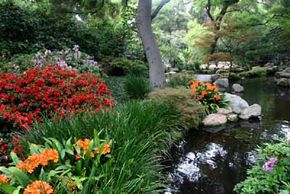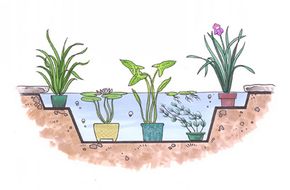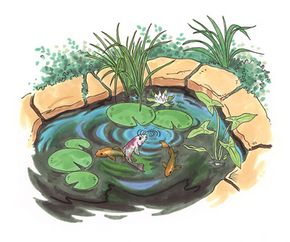Aquatic plants -- aside from being attractive in their own right -- offer numerous advantages to the water gardener. They help filter impurities from the water and, by cutting off intense sunlight, they keep the pond cooler for fish and reduce excessive algae build-up. Aquatic plants also help integrate the water garden into the rest of the landscape. There are several different types of aquatic plants, and each has its own use.
Floating plants are the most "aquatic" of all water garden plants. They simply float on the surface of the water. They help filter the water and cut out sunlight, reducing algae. Many of these are tiny plants, and they help nourish the fish in the pool. Typical examples are duckweed (Lemna) and floating ferns (Salvinia and Azolla). Floating plants may be beached by excessively strong currents, so they do best in still waters.
Submerged plants live out most of their life cycle underwater. Although not very visible, they are essential to a healthy pool because they oxygenate and filter the water, competing directly with algae. For maximum effect, calculate about one cluster of submerged plants per square foot of pool surface. Submerged plants are generally sold unrooted in bunches and should be planted in containers that are then placed at the bottom of the pool. For reduced algae development, about one-third of the pool should be filled with submerged plants.
Emergent plants are the largest and most popular group of aquatic plants. Their roots are solidly anchored in the soil underwater, but their leaves and flowers rise above the water level, where they are easily visible. They are generally grown in baskets placed at the proper depth in the pool. Some, like water lilies, have floating leaves. Others have leaves that rise well above the water. Emergent plants help filter and oxygenate the water and, by their shading effect, reduce algae by cutting off sunlight. Typical emergents include water lilies and lotus. Usually, enough floating-leaf emergents should be used to cover more than half the water surface of the pool.
Bog plants differ from emergent plants in that they grow in wet soil but not with their root systems entirely submerged. There is no clear distinction between bog and emergent plants; many plants are equally at home in wet soil (the official realm of the bog plant) and inundated soil (emergent plant territory). Many common "emergent" plants can also grow as bog plants, including cattails, pickerel rush, and arrowhead. They usually do not appreciate dry soil and should be kept constantly moist.
On the other hand, many so-called "garden plants" can grow in marshy conditions. This latter group includes such popular perennials as forget-me-not (Myosotis scorpioides), bee balm (Monarda didyma), moneywort (Lysimachia nummularia), and chameleon plant (Houttuynia cordata 'Variegata').
Bog plants are most easily maintained by planting them in pots and placing them on low shelves in the pool itself. It is also quite easy to dig a shallow hole at the lower edge of the water garden and cover it with a piece of leftover liner. Filled with soil again, it will remain moderately moist at all times: a perfect habitat for bog plants of all kinds.
Besides being classified as floating, submerged, emergent, or bog, aquatic plants can also be grouped under the labels tropical or hardy. Hardy aquatic plants are those that can be left outdoors year-round just about anywhere in North America. Tropical ones are either treated as annuals in cold climates or brought indoors for the winter.
Special water lily pots, pans, and tubs (generally made of plastic or rubber) are available, but just about any container of appropriate size can be used for aquatic plants. Plastic dish pans, for example, are an ideal size and shape for water lilies and lotus. Plants with less extensive root systems will grow well in ordinary flower pots or even plastic pails. Generally, the containers should be wider than they are deep since water garden plants generally have shallow root systems that spread horizontally. There is no need for drainage holes in aquatic plant containers.
Water lilies and lotus need plenty of root space. Although they can grow in containers holding as little as 9 quarts of soil, 11 quarts is better. Larger containers will allow for future expansion without repotting. Other aquatic and bog plants can be planted in any size container suitable to their root system but give them some room for future expansion. Most aquatic plants will rapidly fill up any container you give them.
Avoid artificial soil mixes, which are too light and tend to float away. Even regular garden soil is likely to cloud the water. Instead, use a heavy garden soil with a fair amount of clay. Do not use soil from a natural pond since it may contain weed seeds or host unwanted pests.
Hose off the plant before potting it up. Carefully spread the roots in the container and fill with soil. Place the crowns at or just below the soil surface. Insert a slow-release fertilizer tablet for aquatic plants (about one per five quarts of soil) as you add soil. Cover the soil with a 1/2 inch layer of rinsed gravel to prevent the soil from floating out. Soak thoroughly before placing the pot in the pool. Containers are easily raised to the required depth by placing bricks or inverted containers under them.
Submerged plants are usually sold as cuttings. Insert the cut ends into sand or soil and cover with gravel as mentioned above. There is no need to add fertilizer tablets since these plants get their nutrients from the water around them.
In our final section, we'll talk about animal life in water gardens.
Looking for more information about water gardens? Try these:



